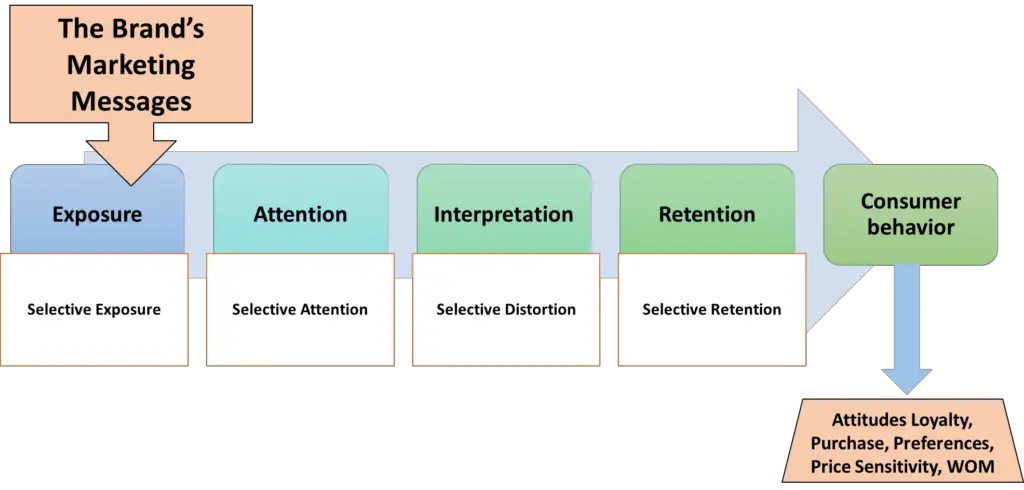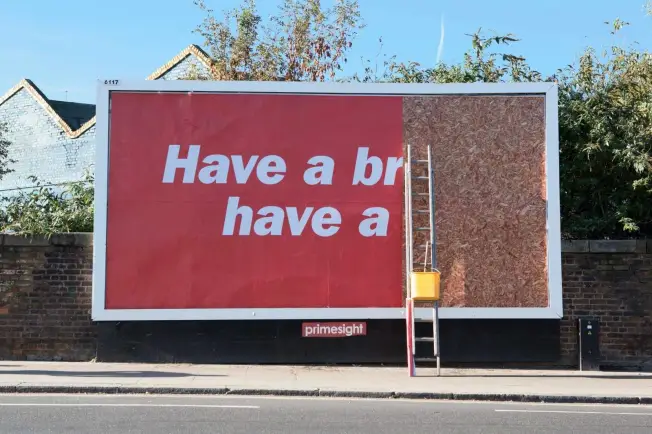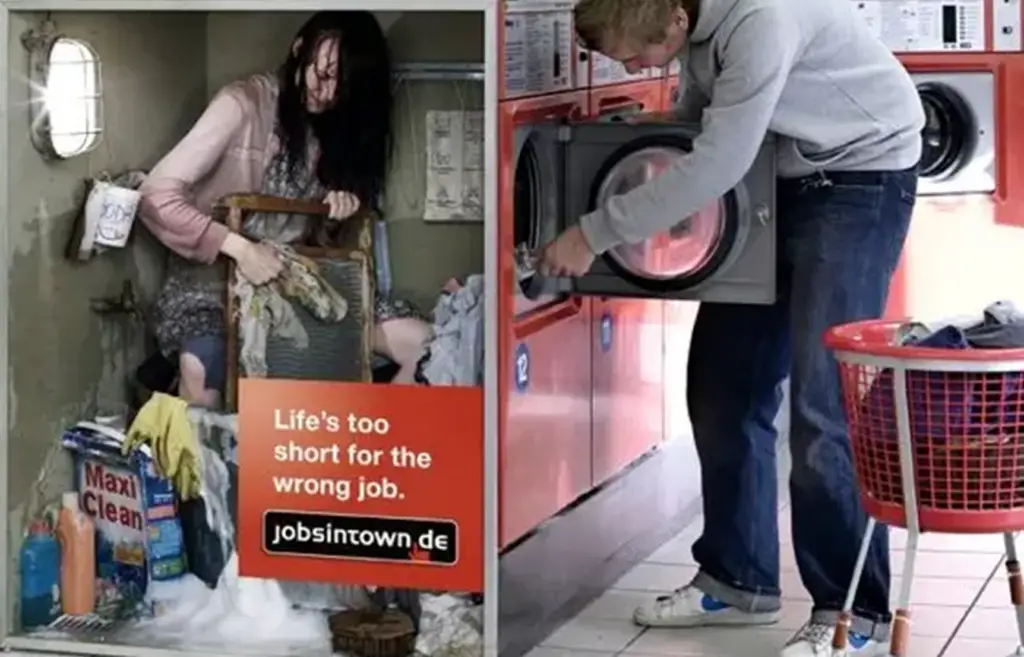An Overview of Selective Attention
A key component of a consumer’s perceptual process is gaining their attention (please see model below).
But as we live in a world where consumers are heavily and precisely targeted with promotional (and other) messages, there are simply too many messages for consumers to process = watch/hear, think about and consider.
As a result, consumers will SELECT which messages and information that they pay any ATTENTION to = known as selective attention.
In other words, consumers will focus their attention on a small proportion of promotional messages only and they will ignore the majority of promotional messages.
For instance, when you walk through a busy shopping mall (or large group of shops) you will be exposed to 100s of signs, posters, deals, products and packaging. And you will only notice and pay attention to a very small percentage of that marketing information.
The reason we do this is because we cannot possibly observe everything – nor are we very interested in everything. Therefore, our thinking will filter out “noise” and focus only on what we consider interesting, different, or relevant to us as consumers.
This means that as marketers, we need to be aware that selective attention is a common behavior across all consumers/segments and it will negatively impact (or reduce) our brand positioning efforts and that we need to address and reduce its effects.
Where Selective Attention Fits into the Perceptual Process
As can see seen in the above diagram, our goal as marketers is to utilize our promotional (and/or other marketing mix elements) messages to influence consumer behavior.
In particular, we want to improve brand attitudes, brand loyalty, increase sales/purchases, strengthen the preference for our brand, reduced price sensitivity toward our brand, and trigger positive word of mouth (WOM).
But standing in our way is selective exposure, selective attention, selective distortion and selective retention. In each step of the perceptual process, the consumer selects (chooses) how they engage and interact and interpret our communications.
By having a good understanding of these barriers and hurdles, we stand a better chance of effectively communicating with and influencing our target market consumers.
What Can Marketers Do to Overcome Selective Attention?
Here are some strategies, ideas, and examples for attention-getting and breaking through the barrier of selective attention.
Understand What Connects and Resonates with your Target Audience
In marketing, not only do we need to understand consumers “needs” but we also need to understand how to engage and interact with our customers and target markets.
A key part of our overall consumer understanding is to know what types of promotional messages, appeals, advertising designs, and so on best connect and resonate with them. We can look to gather this insight through techniques such as :
- Online A/B testing = experiments
- Various forms of market testing
- Focus groups and other qualitative research
- Pre/post promotional marketing research
Create Distinctive and Consistent Brand Elements
Creating and using a distinctive logo, unique brand colors, or a catchy jingle can help your brand cut through the adverting cluttered.
One brand that has managed to do that very effectively is Kit Kat. Most consumers are aware of the Kit Kat logo, tagline and colors – and of course, the product itself.
Here is an example of a very effective Kit Kat that will certainly stand out and grab attention. You will note that the logo or the product do not appear in the ad. In fact, the billboard ad itself is unfinished – which helps draw attention to it as well.
But because the average consumer is very aware of the tagline (have a break, have a Kit Kat), then this ad is a great example of reminder advertising and a great example of how to overcome selective attention.
Use Storytelling
Many people like stories – they tend to be a little more interesting than a traditional and “pushy” advertising message. We can often connect to stories – even if they product behind the story is not relevant to us.
Stories can be an effective way of gaining the consumer’s attention, as well as progressing through the perceptual process and be more likely to be remembered.
In many cases, storytelling techniques can be is a powerful tool for brands in overcoming selective attention. This is because they are less like advertising and more like entertainment.
Utilize Branded Entertainment and Advertainment
Branded entertainment is adding our brands to entertainment – and one form of this tactic is also referred to product placement. We could look to include our brand (often for a fee) in movies, TV shows, podcasts, music videos, video games, events, and/or sponsored blog posts.
Branded entertainment can be quite effective for overcoming selective exposure, as the consumer is usually actively engaged in the entertainment. This is unlike traditional advertising, where the consumer is aware that an ad is coming or has been placed, so they may avoid it.
Branded entertainment also has the advantage of connecting the positive brand association of the show/platform with the brand itself. Therefore, in addition to getting our brand noticed (getting attention) it should also gain in a positive brand connection (by including the brand with something consumers enjoy).
Advertainment is a marketing technique similar to branded entertainment. However, the brand usually creates its own content that is built around its products. A good example here would be The Lego Movie.
Red Bull is another example of a brand that has worked hard with advertainment. Their content often revolves around extreme sports and adventurous activities, which aligns with their brand image of energy and excitement.
Even non-Red Bull consumers are likely to consume their branded content. This means that many people (energy drinkers or not) are aware of Red Bull, and are likely to have a positive attitude toward the brand because they enjoy the content and entertainment.
Using Unexpected Images
One way we can do that is by using images, like in this ad for a job search site placed on machines, pretending there’s someone inside. Obviously, that will grab your attention, making you wonder what it’s all about.
Another example is for a vacuum cleaner brand (Miele), where you’ll be driving along, see a dramatic, unexpected ad, and focus on it. It will grab your attention – effectively bypassing your selective attention barrier.
Use Influencers
Utilizing successful influencers, particularly those relevant to our brand, also help cut through the selective attention barriers. This is because consumers are actively and deliberately reviewing the influencer’s content and are interested in what the influencer is saying, doing and recommending.
This is why major brands will utilize influencers in their marketing activities and are no longer solely relied on traditional advertising methods.
Use Repetition
No doubt you have seen some advertising messages over and over. Or at least, you have seen brands with a very consistent tagline and pitch of benefits in multiple advertising communications.
This is almost like a game of percentages. Given that consumers cannot pay attention to all the ads that they see – then a solution is to repeat the advertising messages over and over – both repeatedly and over a significant time period.
This will simply increase the likelihood that “eventually” a consumer will pay attention to the promotional message, simply because they have more opportunities to do so.
Use Variety of Messaging, Media Channels and Ad Design
This approach is virtually the opposite to the repetition tactic discussed above. In this case, instead of repetition, we use variety.
In terms of variety we are talking about different promotional messages, different benefits being promoted, different advertising and promotional media channels, and different advertising looks and feels.
Why? This will spread the type of promotional message we are using and through diversification simply increase the chances that one of the methods that we utilize will cut through and get the attention of our target market.
The obvious downside to this strategy is that we are adopting a hit/miss approach to our marketing communications – and we would be better off researching and testing the best approach. But in the short term, this approach may be ideal for marketing experiments to identify what works and doesn’t with our target market, in terms of getting their attention.
How Does Selective Attention Impact Brand Positioning?
It goes without saying that selective attention will impact our brand positioning. This is because if our brand is not gain attention of the target audience, then our advertising messages and brand positioning is not communicated in any way.
This means that a significant proportion of our promotional/spend will be wasted. That’s why we need to ensure that we adopt one or more of the marketing tactics listed above in overcoming selective attention.
And we also need to engage in market research and data-driven marketing to ensure that our promotional spend is having the desired effect.
Related Video: Understanding the Perceptual Process in Marketing
Related and Further Information
- What is Selective Exposure?
- What is Selective Distortion?
- Understanding Product Positioning
- The Perceptual Process
- Benefits of Perceptual Maps
- Limitations of Perceptual Maps
Perceptual Maps 4 Marketing
- The Home of the Free Perceptual Map Excel Template
- Downloaded over 100,000 times since 2013
- Always free, always will be
- Ideal tool for marketing students, analysts, and practitioners
Take me to the download page: Free Download of the Perceptual Map Template





